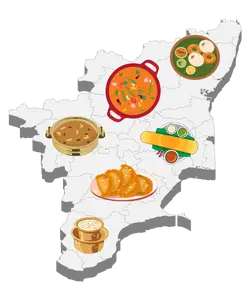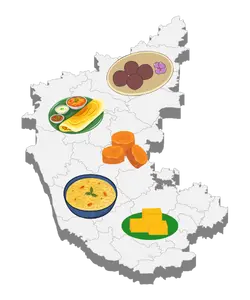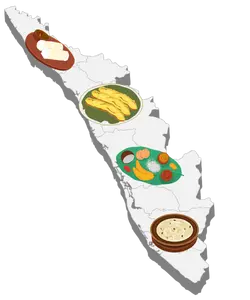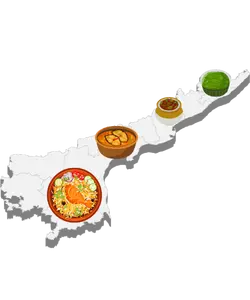The Culinary Map of South Indian Foods, State by State
South India is full of beautiful flavors, culture, and diversity. South Indian food represents more than just food—it’s food culture served on a banana leaf! The South Indian states of Tamil Nadu, Kerala, Karnataka, Andhra Pradesh, and Telangana have some of the most generous uses of spices, coconut, tamarind, and rice-based arrangements in their food, which is also quite wholesome.
This blog will give you the colorful world of amazing South Indian foods in-depth, covering the regional specialties, what dishes you should be trying, and what you should not miss in the flavors of these traditional foods.
Understanding the Basics of South Indian Foods
- A South Indian food experience should consist of
- A South Indian food experience should consist of
- Bold, Spicy, and Sour Flavors
- Vegetarian/Non-Vegetarian Balance
- Generous use of Coconut, Curry Leaves, and Tamarind
- Fresh Chutneys and Podis (spice powder)
- Each meal strives to present an overall experience to unify taste, nutrition, and digestion for the ease of consumption — from lighter breakfasts to moderately lavish lunches to properly settling dinners.
Tamil Nadu Dishes: A State of Bold, Balanced Flavours
Signature Ingredients of Tamil Nadu:
- Tamarind
- Mustard Seeds
- Dried Red Chillies
- Curry Leaves
Tamil Nadu’s food is intense in flavor but well balanced. Their matching food traditions date back thousands of years and are a guide for how they eat today. In Tamil dishes you will find complex gravies such as Kara Kuzhambu and well-crafted Chettinad curries, but you will also find simple dishes like Rasam, Kootu, and Poriyal. Every dish shows a respect for local ingredients and features simple cooking and soulful eating.

Famous Dishes in Tamil Nadu:
- Sambar - A hearty, tangy lentil stew
- Rasam - A peppery tamarind broth
- Pongal - A creamy treat of rice and lentils
- Idli and Dosa - Soft and steamed rice cakes served with crispy crepes
- Chettinad Chicken - a fiery staple among non-veg offerings
Tamil Nadu Food Highlights:
Tamil Nadu’s rich culinary tradition is best experienced through its banana leaf meals, where rice takes center stage and is served with 10–15 vibrant accompaniments that vary by region — from fiery Chettinad gravies to mild Kongu Nadu curries. The tiffin culture thrives all day, with steaming idlis, crispy dosas, and fluffy pongal enjoyed beyond breakfast, always paired with flavorful chutneys and strong filter coffee.
Festivals bring their own specialties like sweet Sakkarai Pongal, soft Kozhukattai, and tangy Sundal, each dish deeply rooted in devotion, culture, and communal joy.
Karnataka Dishes: Sweet, Simple, and Soulful
Signature Ingredients of Karnataka:

- Jaggery
- Tamarind
- Coconut
- Curry Leaves
Karnataka’s cuisine is as varied as its topography — from seaside Udupi temples to palace Mysore kitchens. The state’s cuisine owes a fine balance of delicate sweetness, spiciness, and nutritional value. From the filling Ragi Mudde to the rich Bisi Bele Bath, Karnataka provides comfort food with zest. The dishes are often made with the locally cultivated millets, lentils, and fresh vegetables, making the food both fulfilling and wholesome.
Famous Dishes in Karnataka:
- Bisi Bele Bath - Hot, spiced lentil-rice
- Mysore Masala Dosa - Crispy dosa with red chutney and spicy potato stuffing
- Neer Dosa - Soft and lacey rice crepes
- Ragi Mudde - Finger millet balls with curry or sambar
- Kesari Bath - A scented, sweet semolina sweet
Karnataka Food Highlights:
Udupi-style meal is pure veg and very often onion & garlic free. Festival meal consists of kosambari (lentil salad) and majjige (spiced buttermilk). Most recipes have a hint of sweetness to counter the spiciness
Ragi, Karnataka’s traditional millet, is full of nutrients and now accepted as a worldwide superfood for its medicinal value. Coconut chutneys and pickle pairings are common. Curd is used at the end of the meal to cool the system
Dishes from Kerala: Where Coconut and Curry Rains
Signature Ingredients of Kerala:
- Coconut (grated, milk, oil)
- Mustard Seeds
- Green Chilies
- Curry Leaves
Kerala’s food culture comes from the unique coastline, climate, and centuries’ worth of traditions. They range from rich seafood curries to vegetable goodness. They are generally infused with the essence of fresh coconut and spice(s) typical of Ayurveda. Whether it’s a festive Sadya or an everyday home-cooked meal, each and every bite is always felt as a story of balance, warmth, and freshness. Most dishes are clearly inspired by the state’s preference for the cleanest flavors available and airy softness from the earthy sweet. Cassandra restaurant recipes

Famous Dishes in Kerala:
- Avial - A vegan mixed veggie dish cooked in a thick coconut and yogurt base
- Kerala Sadya - A grand vegetarian meal that consists of 20+ traditional dishes
- Puttu & Kadala Curry: A traditional dish made of steamed rice tubes with spices black chickpeas
- Meen Moilee: A delicate local fish simmered in coconut milk to create a curry
- Appam and stew: Soft rice pancakes accompanied with either a vegetable or meat stew.
Kerala Food Highlights:
Sadya is a required food for Onam, weddings, and temple festivals. Banana chips and pickles are standard accompaniments to any Kerala meal. Coconut oil is the do-it-all oil for cooking, for tempering, and even adding garnishing on top. Vegan and non-vegan meals are known for their aroma but are not overly spicy
Andhra & Telangana Dishes: Strong Flavors Based on Tradition
Signature Ingredients of Andhra & Telangana:

- Red Chillies
- Tamarind
- Gongura Leaves
- Garlic
Andhra Pradesh and Telangana stand out for serving some of the spiciest and most nuanced dishes in the entire country of India. The food is unabashedly hot, full of indigenous ingredients such as gongura, and imbued with ancient cooking traditions. Whether it’s a scorching prawn curry or a warm tamarind rice, these states have dishes that transcend mere heat —they’re richly layered, spiritual, and full of personality.
Famous Dishes in Andhra & Telangana:
- Andhra Meals: A combination of dal, chutneys, hot curries, and pappu
- Gongura Pachadi: Tangy leaf chutney
- Royyala Vepudu: Prawn fry with heat
- Pesarattu: Green gram dosa
- Kodi Kura: Village-style chicken curry
Andhra & Telangana Food Highlights:
Large assortment of pickles, most notably the legendary Avakaya (mango pickle). Generous ghee application in festive foods and sweets. Roti-based items such as Jonna Rotte are prevalent in rural Telangana.
Local Secret: Pulihora, or tamarind rice, is comfort food elevated—served at festival times, temple offerings, and family reunions, marrying taste and tradition with each bite.
Traditional South Indian Foods Served on Banana Leaf
South Indian food is not merely sustenance – it’s a deliberate experience that respects tradition, wellness, and flavor. Traditionally served on banana leaves at special occasions, these foods are presented in an orderly fashion intended to soothe the body and please the senses.
- Salt goes first — establishing balance and flavor predominance.
- Pickles and chutneys follow, providing a pungent kick to alert the taste buds.
- Dry vegetable preparations (poriyal) and moist gravies such as kootu and sambar come next.
- Sambar, rasam, and curd accompany the main rice course for diversity and equilibrium.
- Desserts like payasam or kesari finish the meal with a sweet note.
This old-fashioned order is not by accident — it adheres to Ayurvedic principles that ease digestion and prevent energy slumps. What makes these foods truly exceptional is the balance of spiciness, texture, and sustenance they add to each meal. Whether temple feast or celebratory family lunch, these age-old foods remain central to South Indian food culture.


